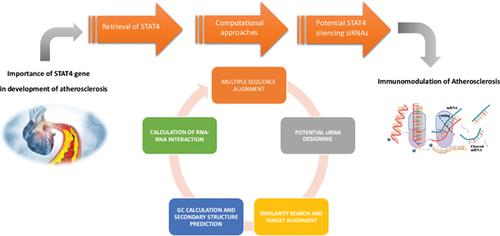Current Computer-Aided Drug Design ( IF 1.7 ) Pub Date : 2020-09-30 , DOI: 10.2174/1573409915666191018125653 Sakineh Poorhosein Fookolaee 1 , Samad Karkhah 2 , Mahdiye Saadi 3, 4 , Subho Majumdar 5, 6 , Ahmad Karkhah 4

|
Background: Small interfering RNAs (siRNAs) are known as commonly used targeting mRNAs tools for suppressing gene expression. Since Signal Transducer and Activator of Transcription 4 (STAT4) is considered as a significant transcription factor for generation and differentiation of Th1 cells during vascular dysfunction and atherosclerosis, suppressing STAT4 could represent novel immunomodulatory therapies against atherosclerosis.
Objective: Therefore, the current study was conducted to design efficient siRNAs specific for STAT4 and to evaluate different criteria affecting their functionality.
Methods: In the present study, all related sequences of STAT4 gene were retrieved from Gen Bank database. Multiple sequence alignment was carried out to recognize Open Reading Frame (ORF) and conserved region. Then, siDirect 2.0 server was applied for the development of candidate siRNA molecules and confirmation of predicted molecules was performed using Dharma siRNA technology and GeneScript siRNA targetfinder. In addition, BLAST tool was used against whole Genebank databases to identify potential off-target genes. DNA/RNA GC content calculator and mfold server were used to calculate GC content and secondary structure prediction of designed siRNA, respectively. Finally, IntaRNA program was used to study the thermodynamics of interaction between predicted siRNA and target gene.
Results: Based on the obtained results, three efficient siRNA molecules were designed and validated for STAT4 gene silencing using computational methods, which may result in suppressing STAT4 gene expression.
Conclusion: According to our results, this study shows that siRNA targeting STAT4 can be considered as a therapeutic agent in many Th1-mediated pathologic conditions specially atherosclerosis.
中文翻译:

开发用于动脉粥样硬化免疫调节的潜在 STAT4 沉默 siRNA 的新计算方法。
背景:小干扰 RNA (siRNA) 是众所周知的常用靶向 mRNA 工具,用于抑制基因表达。由于信号转导和转录激活剂 4 (STAT4) 被认为是血管功能障碍和动脉粥样硬化期间 Th1 细胞生成和分化的重要转录因子,因此抑制 STAT4 可能代表针对动脉粥样硬化的新型免疫调节疗法。
目的:因此,本研究旨在设计针对 STAT4 的高效 siRNA,并评估影响其功能的不同标准。
方法:本研究从Gen Bank数据库中检索到STAT4基因的所有相关序列。进行多序列比对以识别开放阅读框(ORF)和保守区。然后,应用 siDirect 2.0 服务器开发候选 siRNA 分子,并使用 Dharma siRNA 技术和 GeneScript siRNA targetfinder 进行预测分子的确认。此外,BLAST 工具用于针对整个基因库数据库来识别潜在的脱靶基因。DNA/RNA GC含量计算器和mfold server分别用于计算设计siRNA的GC含量和二级结构预测。最后,利用IntaRNA程序研究预测siRNA与靶基因相互作用的热力学。
结果:基于获得的结果,使用计算方法设计并验证了三种有效的siRNA分子用于STAT4基因沉默,这可能导致抑制STAT4基因表达。
结论:根据我们的结果,本研究表明靶向 STAT4 的 siRNA 可被视为治疗许多 Th1 介导的病理状况,特别是动脉粥样硬化的治疗剂。



























 京公网安备 11010802027423号
京公网安备 11010802027423号